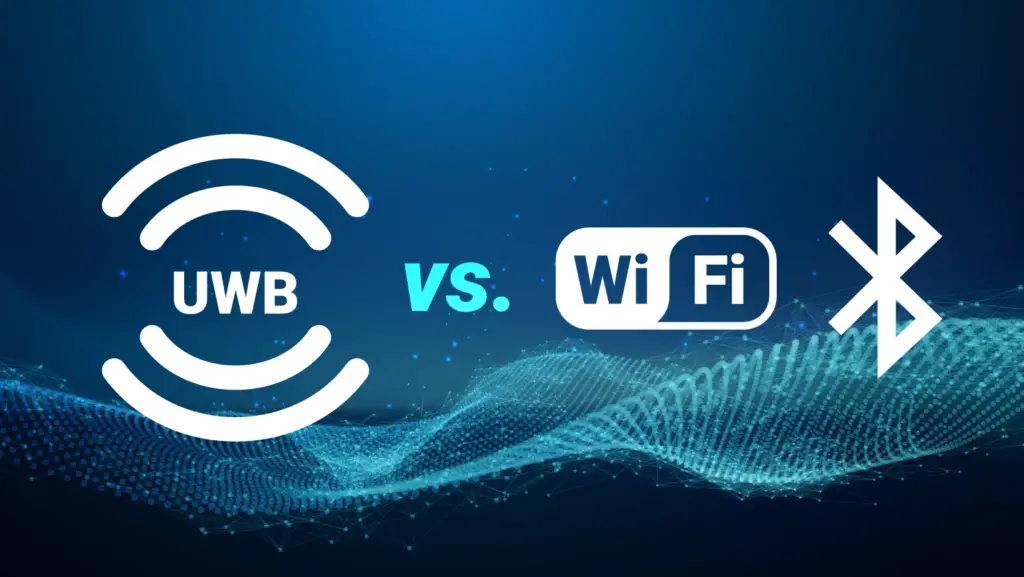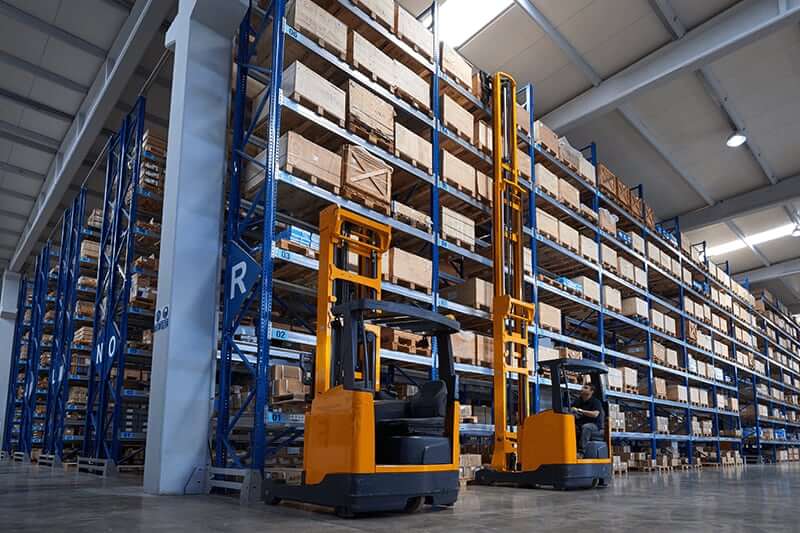Contents
Futurists, technology investors, and entrepreneurs all work together to understand better what the future will look like. Many new technologies are coming to market for the first time on a massive scale leading to quick rapid change for businesses and consumers.
Ultra-wideband (UWB) is one of those technologies poised to change how the world works fundamentally—and do so quickly! UWB is a technology that’s been around for several years now. (1) In 2019 Apple released the world’s first mobile phone with a U1 chip; the ‘U’ in U1 stands for “ultra-wideband.” Samsung and Huawei later began offering smartphones with UWB technology.
Beyond mobile phones, UWB enables the internet of things (IoT), a network of physical objects with sensors, software, and other technologies for connecting with and exchanging data over the internet. UWB is the technology bringing machine learning, software, real-time analytics, and embedded systems together for the IoT industry by adding enhanced connectivity.
What is Ultra-Wideband (UWB)?
Ultra-wideband (UWB) is a low-energy, short-range radio technology similar to Bluetooth for transmitting data wirelessly. It uses minimal amounts of energy for short-range, high-bandwidth communications using a wide range of radio frequencies (RFs).
For UWB to work, it sends billions of pulses of RFs across a wide spectrum of frequencies while a corresponding transceiver translates the pulses into usable information. Pulses are VERY FREQUENT. Normally UWB devices send one pulse every 2 nanoseconds. This translates into approximately 500 million pulses every second! (2)
UWB Safety
The power radiation levels of UWB are strictly regulated around the world and are required not to disturb existing equipment or cause harm to people. The spectrum of frequencies used in ultra-wideband technology and its applications are made to look like background noise.
Ultra-Wideband Vs. Wi-Fi and Bluetooth
UWB allows the distance between two devices to be measured much more precisely than using Bluetooth or Wi-Fi. This precision is possible because UWB enables distance calculations to greater accuracy between two UWB-enabled devices by calculating how long it takes for one radio wave to pass between each device.
Bluetooth and Wi-Fi use conventional radio transmission systems to vary the power level, frequency, or phase of sinusoidal waves. On the other hand, UWB occupies a much larger bandwidth and transmits signals based on generating radio energies at specific time intervals.
The polarity of pulses and their amplitude can be altered, or orthogonal pulses may be used, giving UWB greater flexibility and preciseness than Bluetooth or Wi-Fi technologies.

How Ultra-Wideband is used for spatial awareness
The high frequency of pulsation allows UWB to quickly communicate large amounts of information and provide precise object locations. UWB devices can provide accurate location estimates within a few centimeters of the object’s actual location.
UWB technology can be used to precisely guide people through buildings, find specific items, transfer data to a particular location, and securely transmit data over a short distance using a highly focused stream of information.
Daily use cases of Ultra-Wideband
Initially, a UWB was used for producing RF pulses lasting within a range of sub-nanoseconds for sensing and imaging objects. UWB radars were primarily used for military applications, such as detecting land mines. The private sector recently started adopting UWB radar for commercial purposes, such as medical imaging, ground penetrating, material characterization, and asset tracking. (3)
Real-time positioning and tracking systems (RTLS) with Ultra-Wideband
Real-time positioning and tracking systems (RTLS) using ultra-wideband technology is one of the most practical and useful applications of this technology because it is capable of generating highly precise location data using minimal power. Ultra-wideband technology and its applications are primarily for real-time positioning and tracking to improve workplace safety and operational efficiency in healthcare and industrial settings.
Workplace safety
RTLS with UWB can be applied to improve people’s safety, health, and welfare of people in many occupations.
Collision Warning Systems
RTLS with UWB can be used in industrial settings to provide forklift or robotic collision warning systems with 360-degree awareness. RTLS with UWB can alert others in proximity to forklifts or autonomous robots, automatically control their functions and speed, monitor large working areas, and integrate data with other electronic systems in the working environment.
Employee Safety
Working remotely in the field comes with risks for all parties involved. If something goes wrong, there can be a long delay in figuring out how and why something went wrong. RTLS with UWB allows companies and their employees to have accident and risk monitoring systems (falls, collisions, prolonged inactivity, lone-worker safety, etc…), geo-fencing (for more security and control), automated safety alerts (too close to machinery or areas that may put the worker at risk), and panic buttons to immediately let others know they need help.
Pandemic safety
RTLS with UWB allows accurate logging of workers’ location data to see how well social distancing practices are performed and allows highly accurate contact tracing. If workers test positive for COVID-19, or other infectious diseases, the areas and the people they came in contact with can be monitored, cleaned up, and tested to prevent the further spread of disease within the workplace.
Operational efficiency
The operational efficiency of workers and machines can be improved using RTLS with UWB because of the highly accurate location data and the large amount of data transfer the technology makes possible. Each company will have to implement RTLS with UWB in unique ways to reap the benefits of what is possible. Some common applications of RTLS with UWB for improving operational efficiency include:
Digital keys
UWB enables digital keys that operate based on their precise location between the UWB device and the lock it is programmed to. UWB keys can enable cars and homeowners to unlock doors and devices by using their mobile phones’ built-in UWB technology instead of using standard house keys or car key fobs.
Smart home
Smart home devices made using UWB will be commonplace in the future. UWB allows smart home products to quickly relay information throughout the house and do so in a more secure manner than Bluetooth or Wi-Fi technologies, making UWB smart home devices more secure and cost-efficient.
Medical imaging and monitoring with Ultra-Wideband
The low power consumption of UWB and its high precision makes it ideal for use in environments sensitive to radio frequencies, such as medical environments. It can also quickly identify the position of other objects nearby based on the relative position of the UWB device and the object.

UWB offers unique medical imaging and monitoring systems capabilities because it has powerful obstacle penetration, high precision at the centimeter level, low electromagnetic radiation, and low consumption of processing energy.
The benefits of using UWB in medical imaging and monitoring include: (4)
- UWB imaging and monitoring systems can be designed with extremely low energy consumption requirements, enabling long-life battery-operated medical devices.
- Low radiation produced in UWB is safe for the human body, even at close distances.
- The low noise of UWB allows it to be used with other systems without disrupting their performance, such as wireless sensor networks (WSN), which require strict power control and efficiency.
- UWB pulses possess strong temporal and space resolving capabilities making them suitable for localization and detection in medical applications requiring centimeter-level precision.
- UWB can penetrate through obstacles making it an ideal tool for imaging the human body in medical settings. For example, ultrasound is limited because bones obstruct its view, while UWB imaging is not blocked by bone.
Military Radar
UWB first gained attention for its potential use in radar in the 1990s by the US army who used the technology to build a synthetic aperture radar (SAR), a radar for creating two and three-dimensional reconstructions of objects. UWB SAR technology was developed to locate hidden enemy soldiers and IEDs while remaining at a safe distance.
Data transmission
The extensive throughput capabilities facilitated by UWB render it particularly suitable for various electronic devices such as computers, monitors, cameras, printers, smartphones, and more. This technology enables rapid and secure transfer of large volumes of data between interconnected devices.
Ultra-Wideband is here to stay. What does the future of UWB look like?
Regulation
The regulatory authorities around the world are developing and implementing reasonable regulations surrounding ultra-wideband technology and its applications. The Federal Communications Commission (FCC) of the United States classifies radio technologies as UWB if they have a bandwidth exceeding the lesser 500MHz or 20% of the arithmetic center frequency (the center channel between the upper and lower parts of the radio frequency).
The FCC set different limits for UWB transmitters and emitters. Transmitters have a power spectral density emission limit of -41.3 dBm/MHz, and emitters have a limit of -75 dBm/MHz. These limits are in place for UWB to reduce the technology’s potential to cause harm to people or infrastructure.
Conclusion
The safety of ultra-wideband technology and its applications is no longer a concern. The low energy output of UWB makes them suitable for medical, consumer, and military applications. As the production of UWB chips grows over the coming years (keep in mind UWB was first implemented on a large scale in a consumer product in 2019 with the release of Apple’s U1 chip), so will the number of devices present in our lives with built-in UWB technology.
The mass adoption of UWB technology is inevitable because it is far better than competing technologies for specific applications such as Bluetooth or Wi-Fi. Businesses and consumers looking to make their lives easier and start using the latest UWB technologies will experience more significant opportunities than those who choose not to begin using UWB technology in their businesses and daily lives.




